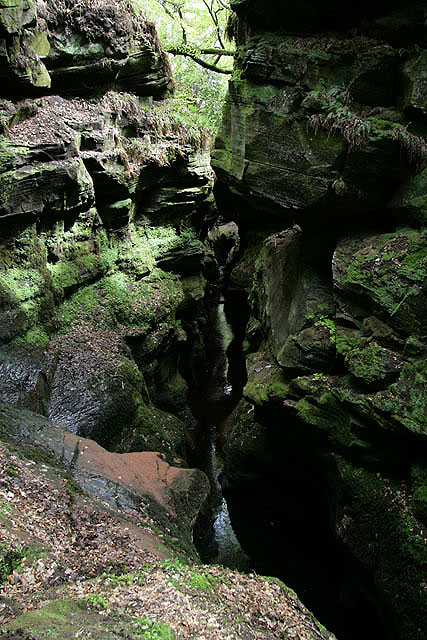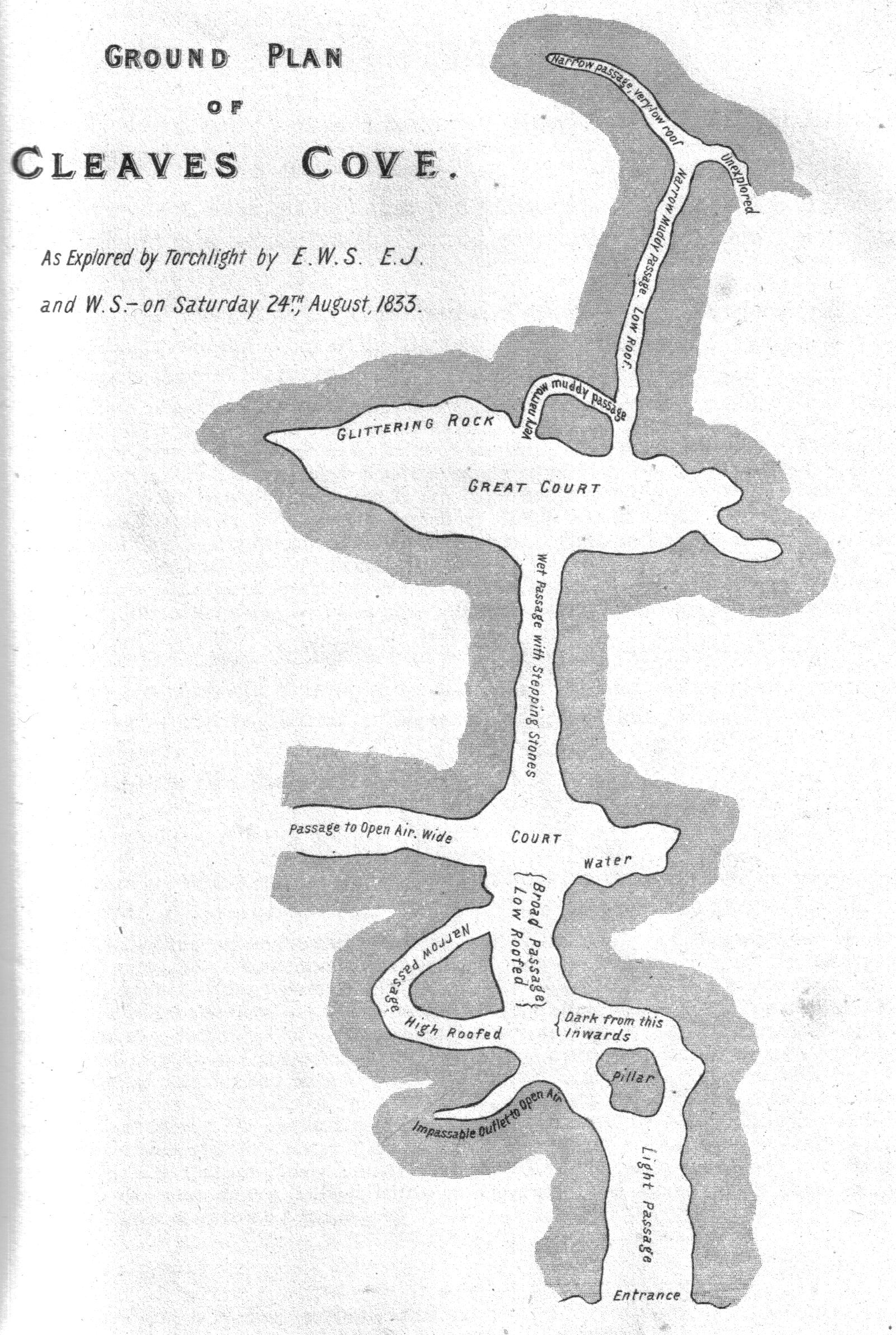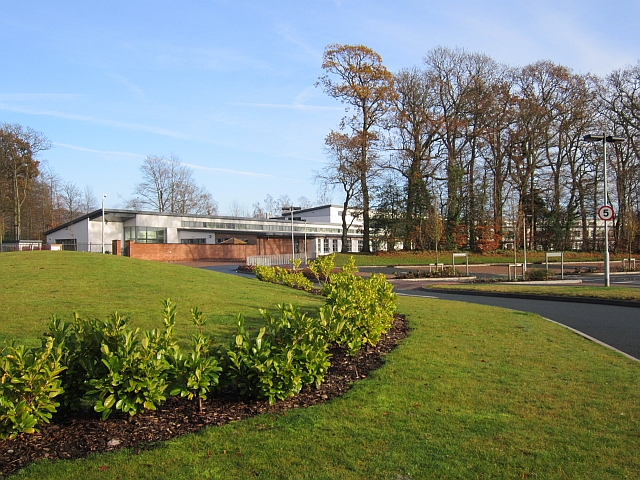|
Crichope Linn
Crichope Linn or Crichop Linn, originally Creehope is a gorge and waterfall near Gatelawbridge in Dumfries and Galloway, southern Scotland. ''Linn'' is the Scots language word for ''waterfall''. The etymology of the names 'Cree' or 'Crich' may derive from Gaelic for 'Boundary' and 'Hope' from the Scots for 'a valley among hills,' an apt description. The Glen and linn It is over deep and is formed from the action of the stream, Crichope Burn, on the soft red sandstone that underlies much of the area. The gorge was long believed to harbour supernatural beings, and a natural rock cell, the "Elf's Kirk" (long since broken up for building stone), stood at its entrance where elves, the supernatural inhabitants of the linn were once said to congregate. A natural archway on the footpath along the side of the gorge bears many 18th and 19th century inscriptions, supposedly including one by Robert Burns. The Ordnance Survey gives a few place names such as the 'Souter's Seat' and 'Burley's ... [...More Info...] [...Related Items...] OR: [Wikipedia] [Google] [Baidu] |
Canyon
A canyon (from ; archaic British English spelling: ''cañon''), or gorge, is a deep cleft between escarpments or cliffs resulting from weathering and the erosion, erosive activity of a river over geologic time scales. Rivers have a natural tendency to cut through underlying surfaces, eventually wearing away rock layers as sediments are removed downstream. A river bed will gradually reach a baseline elevation, which is the same elevation as the body of water into which the river drains. The processes of weathering and erosion will form canyons when the river's River source, headwaters and estuary are at significantly different elevations, particularly through regions where softer rock layers are intermingled with harder layers more resistant to weathering. A canyon may also refer to a rift between two mountain peaks, such as those in ranges including the Rocky Mountains, the Alps, the Himalayas or the Andes. Usually, a river or stream carves out such splits between mountains. Examp ... [...More Info...] [...Related Items...] OR: [Wikipedia] [Google] [Baidu] |
Sir Walter Scott
Sir Walter Scott, 1st Baronet (15 August 1771 – 21 September 1832), was a Scottish novelist, poet, playwright and historian. Many of his works remain classics of European and Scottish literature, notably the novels '' Ivanhoe'', '' Rob Roy'', ''Waverley'', ''Old Mortality'', '' The Heart of Mid-Lothian'' and ''The Bride of Lammermoor'', and the narrative poems '' The Lady of the Lake'' and '' Marmion''. He had a major impact on European and American literature. As an advocate, judge and legal administrator by profession, he combined writing and editing with daily work as Clerk of Session and Sheriff-Depute of Selkirkshire. He was prominent in Edinburgh's Tory establishment, active in the Highland Society, long a president of the Royal Society of Edinburgh (1820–1832), and a vice president of the Society of Antiquaries of Scotland (1827–1829). His knowledge of history and literary facility equipped him to establish the historical novel genre as an exemplar of Europ ... [...More Info...] [...Related Items...] OR: [Wikipedia] [Google] [Baidu] |
Canyons And Gorges Of Scotland
A canyon (from ; archaic British English spelling: ''cañon''), or gorge, is a deep cleft between escarpments or cliffs resulting from weathering and the erosive activity of a river over geologic time scales. Rivers have a natural tendency to cut through underlying surfaces, eventually wearing away rock layers as sediments are removed downstream. A river bed will gradually reach a baseline elevation, which is the same elevation as the body of water into which the river drains. The processes of weathering and erosion will form canyons when the river's headwaters and estuary are at significantly different elevations, particularly through regions where softer rock layers are intermingled with harder layers more resistant to weathering. A canyon may also refer to a rift between two mountain peaks, such as those in ranges including the Rocky Mountains, the Alps, the Himalayas or the Andes. Usually, a river or stream carves out such splits between mountains. Examples of mountain-type c ... [...More Info...] [...Related Items...] OR: [Wikipedia] [Google] [Baidu] |
Landforms Of Dumfries And Galloway
A landform is a natural or anthropogenic land feature on the solid surface of the Earth or other planetary body. Landforms together make up a given terrain, and their arrangement in the landscape is known as topography. Landforms include hills, mountains, canyons, and valleys, as well as shoreline features such as bays, peninsulas, and seas, including submerged features such as mid-ocean ridges, volcanoes, and the great ocean basins. Physical characteristics Landforms are categorized by characteristic physical attributes such as elevation, slope, orientation, stratification, rock exposure and soil type. Gross physical features or landforms include intuitive elements such as berms, mounds, hills, ridges, cliffs, valleys, rivers, peninsulas, volcanoes, and numerous other structural and size-scaled (e.g. ponds vs. lakes, hills vs. mountains) elements including various kinds of inland and oceanic waterbodies and sub-surface features. Mountains, hills, plateaux, and plains are the fou ... [...More Info...] [...Related Items...] OR: [Wikipedia] [Google] [Baidu] |
Cleeves Cove
Cleeves Cove or Blair Cove is a solutional cave system on the Dusk Water in North Ayrshire, Scotland, close to the town of Dalry. Cave system The Cleeves, or Cleaves Cove (Scots) cave system is situated in the lower beds of Carboniferous limestone. It has a total passage length of around . The caves are now well above the level of the Dusk Water and lie close to Cleeves Farm and Blair Mill on the Blair Estate. Many of the stalactites and stalagmites have been damaged by visitors. The cave has three practical entrances facing onto the Dusk Water. A number of older books refer to ''the romantic sylvan dell of Auchenskeigh,'' now Auchenskeith, derived from ''Achadh-na-sgitheach'' - the field of thorns.Dobie, James D. (ed Dobie, J.S.) (1876). ''Cunninghame, Topographized by Timothy Pont'' 1604–1608, with continuations and illustrative notices. Pub. Glasgow : John Tweed. p. 49. The calcareous incrustations in these caves were compared with Gothic fretwork. A number of old limesto ... [...More Info...] [...Related Items...] OR: [Wikipedia] [Google] [Baidu] |
Ellisland Farm
Ellisland Farm lies about 6.5 mi/10.4 km northwest of Dumfries near the village of Auldgirth, located in the Parish of Dunscore, Dumfries and Galloway, Scotland. The complex is a museum in the farm Robert Burns built, lived in and farmed from 1788 until 1791.Wilson, Page 9 History William Roy's map, circa 1747–55, does not show any form of settlement at Ellisland. However William Crawford's 1804 map of Dumfries-shire marks an 'Elliesland' as expected, the farm having been built a few years before. The name is said to be derived from ''"Isle's Land"'', the name of a neighbouring estate.Hendry, Page 42 The river may have been less of a barrier to transport than today and a ford is known to have existed nearby. Patrick Miller of Dalswinton wrote of the area in September 1810, saying; ''"When I purchased this estate about twenty-five years ago, I had not seen it. It was in the most miserable state of exhaustion, and all the tenants in poverty. .... When I went to ... [...More Info...] [...Related Items...] OR: [Wikipedia] [Google] [Baidu] |
Robert Forsyth (writer)
Robert Forsyth (1766–1845), was a Scottish writer, best known for his five-volume work, ''The Beauties of Scotland''. Early life Forsyth was born in Biggar, Lanarkshire, on 18 January 1766, the son of Robert Forsyth, a gravedigger, and Marion Pairman. His parents were poor, but gave him a good education, with a view to making him a minister. Forsyth entered Glasgow College at the age of fourteen, and obtained a license as a probationer of the Church of Scotland (a candidate for minister, serving a required probationary period). Careers Forsyth gained considerable popularity as a probationer, but with no influence, he grew tired of waiting for a parish. He tried to start a career in law, but met with resistance, possibly due to his humble origins. The fact that he was a licentiate of the Church was held as an objection to his being admitted to the bar. Refused by the Faculty of Advocates, he petitioned the court of session for redress. The court ruled that to be admitted ... [...More Info...] [...Related Items...] OR: [Wikipedia] [Google] [Baidu] |
Genius Loci
In classical Roman religion, a ''genius loci'' (plural ''genii locorum'') was the protective spirit of a place. It was often depicted in religious iconography as a figure holding attributes such as a cornucopia, patera (libation bowl) or snake. Many Roman altars found throughout the Western Roman Empire were dedicated to a particular ''genius loci''. The Roman imperial cults of the Emperor and the imperial house developed in part in connections with the sacrifices made by neighborhood associations ''( vici)'' to the local ''genius''. These 265 local districts had their cult organised around the ''Lares Compitales'' (guardian spirits or ''lares'' of the crossroads), which the emperor Augustus transformed into ''Lares Augusti'' along with the ''Genius Augusti''. The emperor's ''genius'' is then regarded as the ''genius loci'' of the Roman Empire as a whole. Roman examples of these ''genii'' can be found, for example, at the church of St. Giles, Tockenham, Wiltshire where the geni ... [...More Info...] [...Related Items...] OR: [Wikipedia] [Google] [Baidu] |
Dalgarnock Village, Church And Parish
Dalgarnock, Dalgarno, Dalgarnoc was an ancient parish and a once considerable sized village in the Nithsdale area of Dumfries and Galloway, Scotland, south of Sanquhar and north of Dumfries that enclosed the parish of Closeburn but was annexed to Closeburn in 1606 following the Reformation, separated again in 1648 and finally re-united in 1697, as part of the process that established the Presbyterian Church of Scotland. It was a burgh of regality bordering the River Nith and Cample Water and held a popular market-tryst or fair from medieval times until 1601 when the Earl of Queensberry had them transferred to Thornhill, commemorated in song by Robert Burns, shortly before its demise and now only a remote churchyard remains at a once busy site. History No houses remained in the 1790s according to the 'Statistical Account for Closeburn' of the once sizeable village, however its location was still familiar to locals in the 1950s and some traces of it could be made out to the ea ... [...More Info...] [...Related Items...] OR: [Wikipedia] [Google] [Baidu] |
Thomas Carlyle
Thomas Carlyle (4 December 17955 February 1881) was a Scottish essayist, historian and philosopher. A leading writer of the Victorian era, he exerted a profound influence on 19th-century art, literature and philosophy. Born in Ecclefechan, Dumfriesshire, Carlyle attended the University of Edinburgh where he excelled in mathematics, inventing the Carlyle circle. After finishing the arts course, he prepared to become a minister in the Burgher Church while working as a schoolmaster. He quit these and several other endeavours before settling on literature, writing for the ''Edinburgh Encyclopædia'' and working as a translator. He found initial success as a disseminator of German literature, then little-known to English readers, through his translations, his ''Life of'' ''Friedrich Schiller'' (1825), and his review essays for various journals. His first major work was a novel entitled ''Sartor Resartus'' (1833–34). After relocating to London, he became famous with his ''French Rev ... [...More Info...] [...Related Items...] OR: [Wikipedia] [Google] [Baidu] |
Closeburn, Dumfries And Galloway
Closeburn (Scottish Gaelic: ''Cill Osbairn'') is a village and civil parish in Dumfries and Galloway, Scotland. The village is on the A76 road south of Thornhill. In the 2001 census, Closeburn had a population of 1,119. Closeburn is recorded as ''Killosbern'' in 1185. The first element of the name is Gaelic ''cill'' 'cell or church'. The second element is a saint's name, but none has definitely been identified. Between 1849 and 1961 the village had a railway station. Although Closeburn railway station is now closed, the Glasgow South Western Line still runs through the village. The nearest stations are at Sanquhar and Dumfries. The village is the former location of Wallace Hall Academy, founded in 1723 and now based in Thornhill. The former schoolhouse, built in 1795 and incorporating the original buildings from the 1720s, is a Category A listed building. Situated east of the village is Closeburn Castle, a Category B listed tower house that was until 1783 the family sea ... [...More Info...] [...Related Items...] OR: [Wikipedia] [Google] [Baidu] |
Wallace Hall Academy
Wallace Hall is a 2-18, state-operated comprehensive school in Thornhill, Dumfries and Galloway, south-west Scotland. The school serves all school-aged children in the local area, with three distinct schooling types operating under one building. These are; The ELC (Early Learning Centre or Nursery), Primary School, and Academy. The ELC and Primary School serves children aged 2–12 located within Thornhill's local catchment area, whilst the Academy serves children aged 11–18 located within Thornhill's local catchment area, as well as a plethora of surrounding rural located Primary schools. As of March 2023, the school operates with a roll of 554 pupils (secondary), and 164 pupils (ELC and primary). History The original Wallace Hall was founded by John Wallace, a merchant in Glasgow and a native of Closeburn, who, in 1717, endowed £1400 for the purpose of erecting the school, on the basis for it to teach English, Latin, Greek, Writing, and Arithmetic, all for the children o ... [...More Info...] [...Related Items...] OR: [Wikipedia] [Google] [Baidu] |




.jpg)






